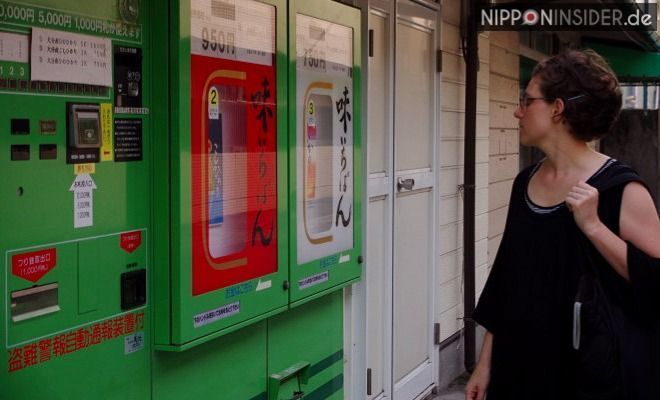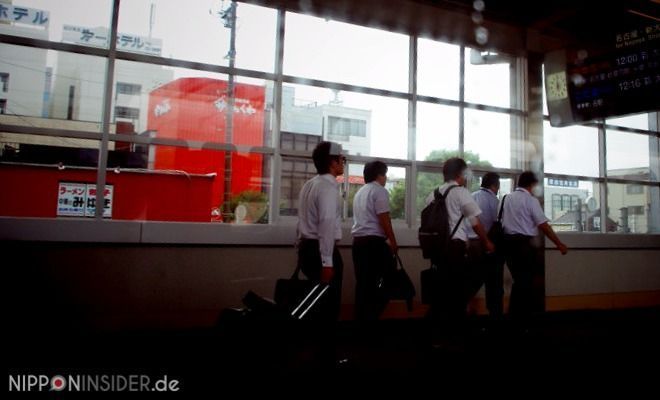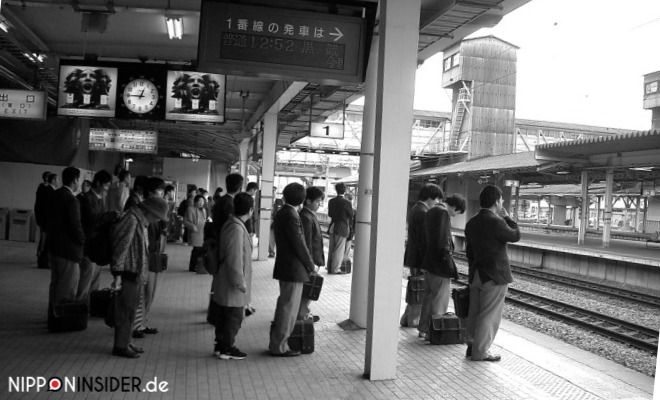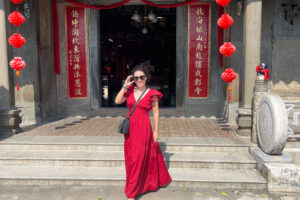Read this in: German
While I was waiting to pay for my shopping in the slowest queue at the supermarket checkout, I discovered a poster: 10-day-round-trip to Japan € 1799 – I read at the discounter with the big A.
A little later at a well-known coffee company I saw a similar offer:
9-day-trip to Japan for € 1,799.
Organized by a German travel agency, including flight, breakfast, sightseeing and entrance fees. Accommodation in a middle class hotel …
Japan – the new Mallorca for Germans?
In Tokyo, the first German bakeries opened their stores, on Hokkaido they are already brewing beer after the German purity law and nowadays every Japanese is able to speak a few words in German: Dankescheen, Ish liibe disch, Prost, …
“Is Japan turning into a new Mallorca for Germans soon?” came to my mind just for a second.
Probably not, since traveling to Japan – even on a guided tour – is still very exotic.
It is not an easy holiday country, no weather-is-always-good-country and no schnitzel-with-fries-country. The land of the rising sun is not a hanging-around-on-the-beach-for-two-weeks-and-reserve-your-deck-chair-country and no Sorry-I-speak-no-English-can-you-speak–in-German-?-Country.
A trip to Japan is challenging you: linguistically, culinary and culturally. Many things are just too different to what you are used to.
But whether you explore the country on your own or you are on a guided group tour: one thing is always included in the price: the culture shock!
You might be wondering, you might be desperate, you might smile, you might just learn from it or simply feel happy.
When it comes to culture shocks, it throws me out of my usual habits at first. I feel insecure, confused and stressed out, but somehow, that’s a part of traveling to Japan and without it, something would be missing. And there are very pleasant “Culture Shockers” as well.
1. Tokyo – the mega metropolis
I have been to Tokyo more than 20 times and each time it’s killing me.
The city has it all.
So many people, so many lights, flashing advertising signs everywhere and there are unusual noises – strange sounds all the time. And I ask myself constantly where to go next. Where to stand without being in someone’s way? Where should I start with my journey of discovery?
I’m standing at the world-famous intersection of Shibuya, when all of a sudden all traffic lights for pedestrians turn to green at the same time. Everybody starts rushing. They are heading left, they are heading right and some just walk crosswise. I don’t move at all just wondering how people are able to walk without bumping into each other. Where did they learn that? At school? Or is there a special course for mastering situations like this?
The lights turn green again and it’s going to be my turn now. I’m gliding into the stream, get pulled along with the crowd and it works quite well. That’s the way, Tokyo is working.
My tips:
1
Be surprised for a moment and then enjoy experiencing in the city.
2
Make a simple plan for the day, but take it easy. Make sure to have some time left for yourself to independently explore the city.
3
Just walk around in different vicinities. Photo opportunities are awaiting you around every corner. Your memory card of your camera will save the most typical pictures, I’m sure. You can compare them with mine in one of my former articles: The Top 5 Photos of Japan.
4
I like to relax in a nice quiet café to recover from my culture shock. And while recovering I take a look at the Japanese and their fashion. Tokyo’s fashion is setting trends and often appears in Germany one or two years later.
2. Writing and language
Suddenly I fee transported back to my childhood, when I could neither read nor write.
Signs with unknown characters are everywhere and I am not even able to figure out behind which door the women’s restroom may hide. Menus at the restaurant, ticket machines at the station, remote controls for the air conditioning in the hotel, toilets (they often use remotecontrols for toilets), street signs,…
All that characters are so gorgeous, but unfortunately I can’t read any of them.
And what is wrapped in all this packaged stuff in the supermarket? I would love to know. Just to get milk is a going to be a great adventure for me.
If you cannot read anything, just ask someone for help. If you dare.
A lot of Japanese people study English at school, but that doesn’t mean that they understand me. And if they do understand and even respond, it still doesn’t mean that I understand them. The Japanese accent (as our German) needs some practice to get used to it.
Beli Gutto is English and means very good.
Zank ju beri matchi is also English for Thank you very much!
My tips:
1
Memorize the basic Japanese phrases (LINK: http://nipponinsider.de/nuetzliche-ausdruecke-1/).
2
When speaking English, it’s always important to smile a lot and praise the English-speaking Japanese person as much as possible.
3
Important addresses and words such as “toilet” or questions like “How much is it?”, “Does this contain meat?”, “Does this contain peanuts?” are written in my small notebook – in English and of cause in Japanese and with Japanese characters. One page for each phrase. And in an emergency I simply point to that page.
4
I always took the opportunity to ask questions and practice my Japanese when I met Japanese people who spoke excellent English (yes, they are existing!). So I could get answers to all of my questions about Japan and expand my notebook with more Japanese expressions.
3. Fish for breakfast
Traveling to Japan I want to experience as much as possible.
I want the full package: A Japanese hotel room (a futon on the tatami mat) and of course Japanese breakfast. The Japanese food is supposed to be very healthy.
Is it indeed: rice, pickled vegetables, soup, egg and grilled salmon.
To be honest, it took some time until my stomach and I got used to Japanese breakfast. And though it is tasty my German tummy is calling out for bread or a bun sometimes. Topped with smoked salmon would be nice, though.
My tips:
1
Try Japanese breakfast.
2
Also try natto*. For this someone needed to show me how to eat it. And when I mentioned that it was my first time, everybody came to watch me trying my first natto.
I did not finish it. I could not. It just didn’t like the taste, even if it is said to be very healthy. But in the end it was ok for everyone that I didn’t continue eating. Alone for trying natto I was admired by my observers.
* Natto – fermented soybeans, having it’s very own texture and very special smell.
4. Me in the middle of suits
“What kind of celebration is going on today?” came to my mind on the train, when I saw lots of men in suits. “Are they all going to a wedding?” Wearing a suit and tie is nothing special but a regular business dress code. Women are often seen in costumes in muted colours.
I’m quite noticeable here with my comfortable travel outfit and colourful backpack
I feel very confused when all Japanese eyes are focusing on me. “They are all staring at me!” I’m constantly thinking. I’ve never been so aware of my appearance as in Japan. I look different here. Actually I’m quite normal looking for a non-Japanese with my brown curls, the pointed nose and brown eyes. However, in Japan I’m different. I had to get used to it that everybody is looking or even staring at me.
Luckily I’m only 160 cm tall and at least I have something in common with most of Japanese people.
My advice:
If someone stares at me, I smile and greet. Often a nice conversation started out of this situation.
5. The train which came on time
A culture shock of pleasant nature was rail travel in Japan.
My world of train travel looks like this: waiting for delayed trains, cancellations due to not working air conditioning or missing of connecting trains. I always thought it has to be that way, it’s the so called “train travel experience”.
Wikipedia says something similar: “…For Deutsche Bahn AG, a train is considered on time if it arrives or departs 5 minutes and 59 seconds after the timetable…” (LINK: https: // de.wikipedia.org/wiki/P%C3%Bcnktlichkeit_(Bahn))
Therefore I was pleasantly surprised by the Japanese trains always being on time.
Ok, the Shinkansen, the fast trains in Japan have a private line network and can move without being interrupted by slower trains. When the earth starts to shake, they stop immediately.
Therefore, the average delay time per year is about one minute !!!
6. Waiting in the line
Also I have been amazed when I saw people waiting for a train on the platform.
They are lined up in front of a special sign on the ground, where the train is supposed to stop. That the train with the doors stopped precisely at these points put me in astonishment again. As the doors opened, people who were waiting on the platform started to form a free passageway for all those who wanted to get off the train. Only after having let the last passenger pass by they got on the train in a calm mannered way.
This worked extremely well even at the crowded subway stations in Tokyo.
I would like to introduce this to Berlin one day.
And while I’m at it, I would also like to introduce another Japanese system – the way how customers are waiting at the checkout in a supermarket:
In Japan when a new checkout at the supermarket is going to open because the queue is too long – means, that more than 3 customers are waiting in line – the first waiting customer from the “long queue” is requested to switch to the free checkout. A customer from the back would never come up with the idea to pass all those waiting people to go over to the newly opened checkout!!!
The system is actually quite simple, fair and… why it’s not working in Germany?
All this came to my mind while standing at the discounters checkout yesterday.
When it finally was my turn to pay I recognized some people forming in a new line in front of a still closed checkout, which was going to open soon, I guess.
I smiled at the man behind the counter who was waiting for me to pay, pointed with a nod to the poster with the Japan-offer and asked him: “Have you ever been to a Japanese supermarket?”


























1 Comment
I’m so sorry but I am not even slightly interested in going any where there. It was a very good blog. So good it helped me realize this would never be for me.